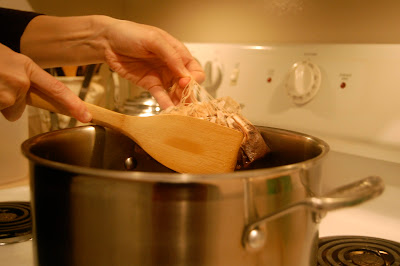 Yesterday we talked about the benefits of bone broth. Today, I'm sharing my recipe for chicken broth. I make this chicken broth at least once a week. It's golden, rich, and delicious - you won't be disappointed. We'll also be considering different methods of cooking broth and various storage possibilities.
Yesterday we talked about the benefits of bone broth. Today, I'm sharing my recipe for chicken broth. I make this chicken broth at least once a week. It's golden, rich, and delicious - you won't be disappointed. We'll also be considering different methods of cooking broth and various storage possibilities.
If you were to ask around, you’d find that most people make chicken broth more often than any other sort of broth. It’s the easiest to make, and in the average American household, we probably tend to eat chicken more than beef or fish. That being said, both beef and fish broths are just as beneficial and even offer some nutrients that chicken broth does not. So, while today’s recipe is for chicken broth, feel free to experiment with other types in the future.
There are a few ways to make bone broths, but let’s first start with the basic recipe, and then discuss your options.
Basic Homemade Chicken Broth
Giblets from chicken (heart, neck, liver, etc.)
2 tablespoons organic, raw apple cider vinegar (I use Bragg’s)
2 organic onions, chopped
4 organic celery stalks, chopped
3 organic carrots, chopped
Filtered water
1. Place the bones, giblets, and chicken feet into a large stockpot. Pour the apple cider vinegar over the bones and let sit for 30 minutes to an hour. This helps to pull out the minerals, like calcium, from the bones.
2. Add the chopped veggies and cover with filtered water about an inch above the top of the ingredients. Bring to just before a boil, turn heat down to very low, and remove the scum that has risen to the top.
3. Keep broth at a very low simmer for at least 3 hours, ideally 24 hours. The longer you simmer the more flavor and nutrients will be added to the broth.
4. When finished simmering, strain broth through a colander.
Various Broth-Making Methods
If you scrounge around the internet you’ll find a myriad of creative ways to make broth. Below you’ll find a few of my favorites.
Slowcooker Broth: Make your broth in your crockpot or slowcooker (following the recipe above). If you’re not used to leaving your house with your stove on, this might be a good solution for you. Be careful though, sometimes crockpots can’t heat the broth low enough and even on the warm setting the broth ends up boiling - something you want to avoid.
Perpetual Chicken Broth: Continuing with the idea of the slowcooker method, some like to continually cook broth on their countertop, adding more bones throughout the week and ladling out whatever they need at each meal. This allows your broth to be available and ready to go whenever you need it. You can read more about this method over at Nourished Kitchen.
Whole Chicken Broth: You can also begin your broth by using a whole, uncooked chicken. If you do this, follow the recipe as written above, but remove the chicken from the stockpot after 2 hours, carefully remove the meat from the bones, and place the bones back in to simmer for the remaining time. Store the meat in the fridge to use later in salads or soups. If you leave the meat in the broth for the full 24 hours, it tends to become quite tough.
Broth Storage Options
Chicken broth will last in your fridge for about a week, but if you can’t use a gallon of broth in a week, what do you do? Some people freeze their broth in small (2-3 cup) containers, so that they only have to defrost what they will use in one meal. You can also freeze the broth in ice cube trays, and then store the frozen cubes in a freezer bag. This works well when you only want to use a small amount of broth for cooking veggies, grains, or for use in sauces. You can use a combination of the above choices to work out the best solution for your family.
Now that you have a recipe, start saving those leftover chicken bones, and get ready to have this incredibly healthy, mineral-packed, delicious broth on hand. Are you still looking for an excuse to make it? Join me in my next post as I share my recipe for the absolute best chicken soup you've ever eaten, a perfect hearty dinner for these cold winter days.
Are you going to try making chicken broth for your family?
If you did, how did it turn out?






















